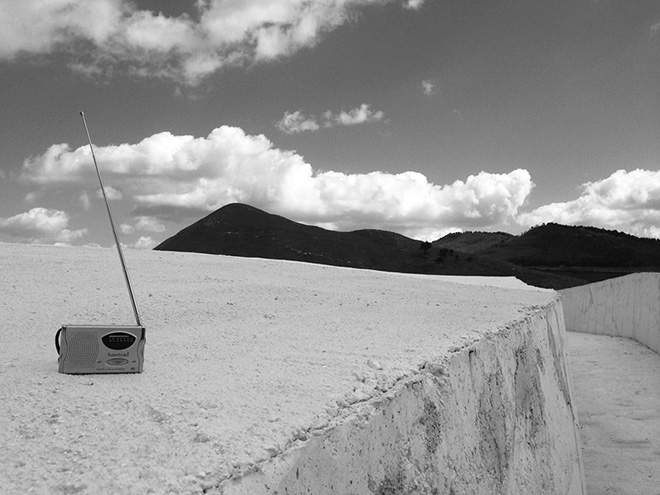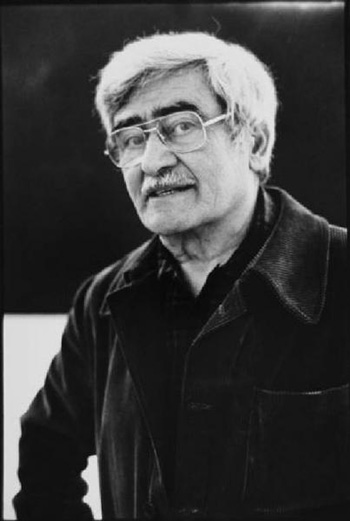In January of 1968 a violent earthquake hit a vast area of Western Sicily between the provinces of Agrigento, Trapani and Palermo. The village of Gibellina, among the worst-hit by the quake, was almost completely destroyed.
A few years later Gibellina was rebuilt a few miles away and the Mayor, Ludovico Corrao, called for the help of internationally known architects, urbanists and artists. Invited by Corrao, Alberto Burri refused to intervene in the “new” Gibellina but proposed a gigantic Land Art installation that would completely cover the ruins of the old village destroyed by the earthquake: the Grande Cretto. T
he work was built between 1984 and 1989 but it was never completed. This year, on the occasion of Alberto Burri’s 100th anniversary which will culminate on October 10th with a retrospective at the Guggenheim in New York, the Grande Cretto was finally completed according to the original project.
AUDIOGHOST 68 is an opera for lights, sounds and a thousand actors specially created for Alberto Burri’s Grande Cretto by Anglo-Italian musician Robert Del Naja and Italian artist Giancarlo Neri on the occasion of the great Italian artist’s 100th birth anniversary.
One thousand white fireflies move and dance in the night in all directions inside the “veins” of the Cretto, their moving light sculpting the dark shapes of the Cretto’s islands and forming a great luminous mosaic in constant evolution.
In the air, coming from who knows where, are the sounds and voices of a long-gone era, that year 1968 that changed the world for a long moment but that here, in Gibellina, like a true Apocalypse, marked the end of it.
Alberto Burri’s Grande Cretto, remembering but also hiding the tragic event under concrete, represents a return to life through art. We would like to pay homage to this great piece, and to the great artist who created it, with a “collective” work that would further underscore its greatness: tonight, it will take a thousand of us.
Robert Del Naja and Giancarlo Neri
--
More about AudioGhost68...
...in the Italian English-written Nero Magazine:

AUDIOGHOST68 by Robert Del Naja and Giancarlo Neri at Cretto di Burri in Gibellina
On the occasion of Alberto Burri’s 100th birthday anniversary E.ON and the City of Gibellina, as part of the first edition of the Cretto Earth Festival, present AUDIOGHOST68, a work composed of lights, sounds and a thousand actors especially created for Burri’s Grande Cretto by Anglo-Italian musician Robert Del Naja and Italian artist Giancarlo Neri.
Over a year ago we published the book La Linea della Palma which presents the field work research produced by the participants of the programme Studio Roma of the Swiss Institute of Rome, in the spring of 2014 in Valle del Belice, Sicily. Research which does not consider the catastrophe – the earthquake in January 1968 – as a univocal and linear element, but ventures into new paths, free from pre-existing narratives. As an attempt to question the possibility of understanding a territory by following its geography, research participants contributed individually or collectively to the construction of a fluid body of images, sounds and texts that define a space of knowledge. Each participant freely took a position within the physical, historical and social context of this area, and from that position offered personal knowledge and skills that intertwined with those of others – a reading of the territory.
For Alberto Burri’s 100th birthday anniversary, among the many events organized this year, and perhaps most noteworthy is the final completion of the Grande Cretto – originally constructed between 1984 and 1989.
On this occasion E.ON and the City of Gibellina, present AUDIOGHOST68: One thousand white fireflies move and dance in the night in all directions inside the “veins” of the Cretto, their moving light sculpting the dark shapes of the Cretto’s islands and forming a great luminous mosaic in constant evolution. In the air, coming from who knows where, are the sounds and voices of a long-gone era. 1968 was a year that changed the world irrevocably. Here, in Gibellina, like a true Apocalypse, its end was marked.
In AUDIOGHOST68 the work, the actors and the public merge together, becoming one.
On their arrival at the Cretto at 8 pm, the actors/spectators, equipped with a LED light headband, position themselves along the entire perimeter of the piece, yet with their lights turned off. At a given signal – the start of the sound effects broadcast in FM – the “actors” light their lamps and enter the Cretto from all directions to move freely inside the “veins” of the great sculpture, forming rivers, trails, clusters, and single dots of moving light. At the same time, the sounds and the voices of 1968 are spread through the air to be transformed, after a moment of absolute silence, into an explosion of percussion, music, and dance.
Featuring Percussion Voyager and Max Passante.
NERO is a quarterly contemporary culture magazine – distributed in Europe and in the US – as well as a publishing house specialized in the production of artist’s books, editions, and catalogues commissioned by museums, foundations and private collections. NERO also works in curating, art direction and consulting for cultural projects and contemporary art.
NERO è una rivista trimestrale di cultura contemporanea – distribuita in Europa e negli Stati Uniti – e una casa editrice specializzata in libri d’artista, edizioni, e cataloghi per conto di musei, fondazioni e collezioni private. NERO si occupa anche della cura, direzione artistica e consulenza di progetti culturali e artistici.
--
... and in Italian in Arts Vibes:
L’arte si fa in mille di Robert Del Naja e Giancarlo Neri
Redazione Art-Vibes | On 14, ott 2015
Il ritorno alla vita attraverso l’arte: una suggestiva installazione partecipativa celebra il Grande Cretto di Alberto Burri.
di Redazione Art Vibes
In occasione del centenario della nascita di Alberto Burri, la multinazionale energetica E.ON e il comune diGibellina, all’interno della prima edizione del “Cretto Earth Fest”, presentano AUDIOGHOST68, un’opera per luci, suoni, e mille attori appositamente concepita per il Grande Cretto dal musicista anglo-italiano Robert Del Naja e dall’artista Giancarlo Neri.
Nel Gennaio del 1968 un violento terremoto colpì una vasta area della Sicilia occidentale tra le provincie diAgrigento, Trapani e Palermo. Gibellina, tra i paesi più colpiti dal sisma, fu quasi completamente rasa al suolo. Alcuni anni dopo Gibellina fu ricostruita a pochi chilometri di distanza e il sindaco, Ludovico Corrao, volle coinvolgere nella ricostruzione architetti, urbanisti e artisti di fama internazionale. Invitato da Corrao, Alberto Burri non volle intervenire nella “nuova” Gibellina ma propose una gigantesca opera di Land Art che avrebbe completamente coperto le macerie del paese distrutto dal terremoto: il Grande Cretto.
L’opera fu realizzata tra il 1984 e il 1989 ma non fu mai completata. Quest’anno, in occasione del centenario della nascita di Alberto Burri che culminerà il 10 ottobre con una retrospettiva dell’artista al Guggenheim di New York, il Grande Cretto è stato finalmente ultimato secondo il progetto originale.
AUDIOGHOST68
Mille lucciole bianche si muovono e danzano nella notte tra le “vene” del Cretto in tutte le direzioni, la loro luce in movimento scolpisce le forme buie delle isole di cemento formando un grande mosaico luminoso in continua evoluzione…
Nell’aria, provenienti da chissà dove, i suoni e le vocidi un’epoca ormai lontana, quel 1968 che cambiò le sorti del mondo per un lunghissimo momento ma che qui, a Gibellina, ne segnò la fine come una vera Apocalisse.
Mille lucciole bianche si muovono e danzano nella notte tra le “vene” del Cretto in tutte le direzioni, la loro luce in movimento scolpisce le forme buie delle isole di cemento formando un grande mosaico luminoso in continua evoluzione…
Nell’aria, provenienti da chissà dove, i suoni e le vocidi un’epoca ormai lontana, quel 1968 che cambiò le sorti del mondo per un lunghissimo momento ma che qui, a Gibellina, ne segnò la fine come una vera Apocalisse.
In AUDIOGHOST68 l’opera, gli attori e il pubblico sono una sola cosa. All’arrivo al Cretto alle ore 20, gli attori/spettatori vengono equipaggiati con una torcia a LED da indossare sulla fronte e si dispongono lungo tutto il perimetro dell’opera a luci spente.
A un segnale convenuto, l’inizio degli effetti sonori trasmessi in FM da piccole radio disseminate su tutta la superficie del Cretto, gli “attori” accendono le lampade ed entrano nel Cretto da tutte le direzioni per poi muoversi liberamente per le “vene” della grande scultura formando fiumi, scie, grumi, e singoli puntini di luce in movimento mentre i suoni e le voci del 1968 si diffondono nell’etere per trasformarsi, dopo un momento di silenzio assoluto, in una esplosione di percussioni, musica e danze, con la partecipazione di Percussion Voyager e Max Passante.
--
Giancarlo Neri è un artista nato a Napoli nel 1955 ed è uno dei maggiori autori italiani di installazioni di grandi dimensioni e arte pubblica. Neri si trasferisce a New York nel 1978 dove studia alla “Art Students League”.
Dopo gli inizi come pittore si dedica alla realizzazione di installazioni di grandi dimensioni negli U.S.A., in Brasile e in Europa. Tra le sue opere più note “Still Night” (1989) alla Clocktower Gallery/P.S.1 di New York, “180 Sedie a Capri” (1991), “The Writer” (2005) a Londra e Roma, “Massimo Silenzio” (2007) al Circo Massimo di Roma, “Vincere si deve la sorte” (2010) sul Cretto di Burri a Gibellina e “Máximo Silêncio em Paris” (2012) a Rio de Janeiro.
Del Naja ha iniziato la sua carriera come graffiti artist a Bristol ed è considerato uno dei pionieri della stencil art, citato dall’artista Bansky come sua maggiore influenza. Del Naja è anche co-autore di varie installazioni audio-visive tra cui Volume in collaborazione con il gruppo UVA al Victoria & Albert Museum di Londra nel 2013, Meltdown Festival al Southbank Centre (Londra, 2008) e Massive Attack v Adam Curtis al Manchester International festival e alla Armory NYC nel 2013 con il regista Adam Curtis.
Percussion Voyager sono un duo di percussioni tra i più originali e richiesti in Italia. Nati nel 1998dall’incontro tra Maurizio Rizzuto e Matteo Scaioli, hanno legato il loro nome ai più importanti club italiani collaborando con top DJs italiani ed internazionali. I Percussion Voyager si sono esibiti in vari festival sia in Italia (Mtv Coca Cola Live Tour, ArezzoWave, Intermittenze) sia all’estero (in Brasile, a Capoverde, e in Germania).
Max Passante DJ e produttore, lavora principalmente tra Roma, New York e Londra. Nel 1995, assieme aiPlanet Funk, crea l’etichetta indipendente Bustin’ Loose Recordings contribuendo al lancio di artisti qualiKaren Ramirez, Gaudi e Hondy. Collabora stabilmente con i Massive Attack. Si è esibito nei principali festival musicali del mondo (Bestival, Big Chill, Secret Garden e Romaeuropa). Per il cinema ha supervisionato le colonne sonore di “Gomorra” e “Reality” di Matteo Garrone ed è stato consulente musicale per i film “The Beach” e “Entrapment”.
Locandina, AUDIOGHOST68 – L’arte si fa in mille, un progetto di Robert Del Naja e Giancarlo Neri




No comments:
Post a Comment